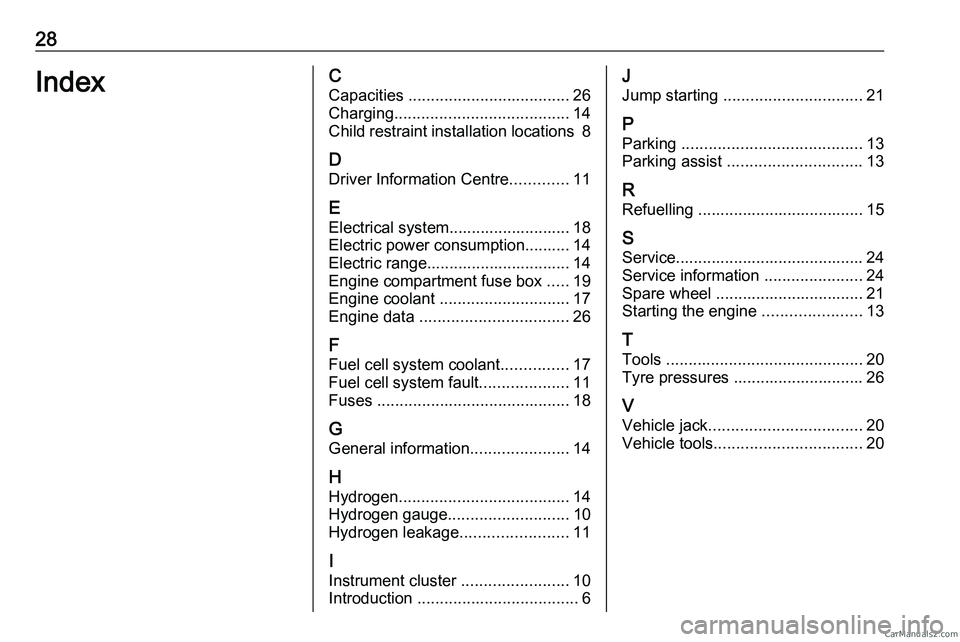Page 314 of 348

22 Vehicle care
● Do not disconnect the discharged vehicle battery from the vehicle.
● Switch off all unnecessary electrical consumers.
● Do not lean over the vehicle battery during jump starting.
● Do not allow the terminals of one lead to touch those of the other
lead.
● The vehicles must not come into contact with each other during
the jump starting process.
● Apply the parking brake, transmission in neutral,
automatic transmission in P. Disengage the cover of the fuse box
in the engine compartment to access
the positive terminal of the vehicle
battery.
Lead connection order:
1.
Connect the red lead to the
positive terminal (1) of the booster
battery. 2. Connect the other end of the red
lead to the positive terminal ( 2) of
the discharged battery.
3.
Connect the black lead to the
negative terminal ( 3) of the
booster battery. 4. Connect
the other end of the black
lead to the vehicle grounding point
(4) of your vehicle in the engine
compartment.
Route the leads so that they cannot
catch on rotating parts in the engine
compartment.
To start the engine: 1. Start the engine of the vehicle providing the jump.
2. After 5 minutes, start the other engine. Start attempts should be
made for no longer than 15
seconds at an interval of 1 minute.CarM an uals 2 .c o m
Page 315 of 348
Vehicle care 23
3. Allow both engines to idle for approx. three minutes with the
leads connected.
4.
Switch on electrical consumers
e.g. headlights, heated rear
window of the vehicle receiving
the jump start.
5. Reverse above sequence exactly when removing leads.CarM an uals 2 .c o m
Page 317 of 348
Technical data 25
Technical data
Vehicle data ................................. 26
Engine data ............................... 26
Capacities .................................. 26
Tyre pressures .......................... 26CarM an uals 2 .c o m
Page 318 of 348
26 Technical data
Vehicle data Engine data Fuel cell vehicle
Engine power [kW] 100
Fuel cell power [kW] 45
Fuel type Hydrogen
Combined range (high voltage battery and fuel cell) approx. 400 kmCapacities
Hydrogen tanks
Hydrogen, refilling quantity [kg] 4.4High voltage battery
Battery capacity [kWh] 10.5Tyre pressures
Regarding tyre pressures for a
specific vehicle, refer to the tyre
pressure information label on the B-
pillar. The tyre pressure information label
indicates
the original equipment tyres
and the correspondent tyre
pressures.CarM an uals 2 .c o m
Page 320 of 348

28
Index C
Capacities .................................... 26
Charging ....................................... 14
Child
restraint installation locations 8
D Driver Information Centre .............11
E Electrical system........................... 18
Electric power consumption.......... 14
Electric range................................ 14
Engine compartment fuse box .....19
Engine coolant ............................. 17
Engine data ................................. 26
F
Fuel cell system coolant ...............17
Fuel cell system fault.................... 11
Fuses ........................................... 18
G General information ......................14
H Hydrogen ...................................... 14
Hydrogen gauge ........................... 10
Hydrogen leakage ........................11
I
Instrument cluster ........................ 10
Introduction .................................... 6 J
Jump starting ............................... 21
P Parking ........................................ 13
Parking assist .............................. 13
R Refuelling
..................................... 15
S Service.......................................... 24
Service information ......................24
Spare wheel ................................. 21
Starting the engine ......................13
T
Tools ............................................ 20
Tyre pressures ............................. 26
V Vehicle jack .................................. 20
Vehicle tools ................................. 20CarM an uals 2 .c o m